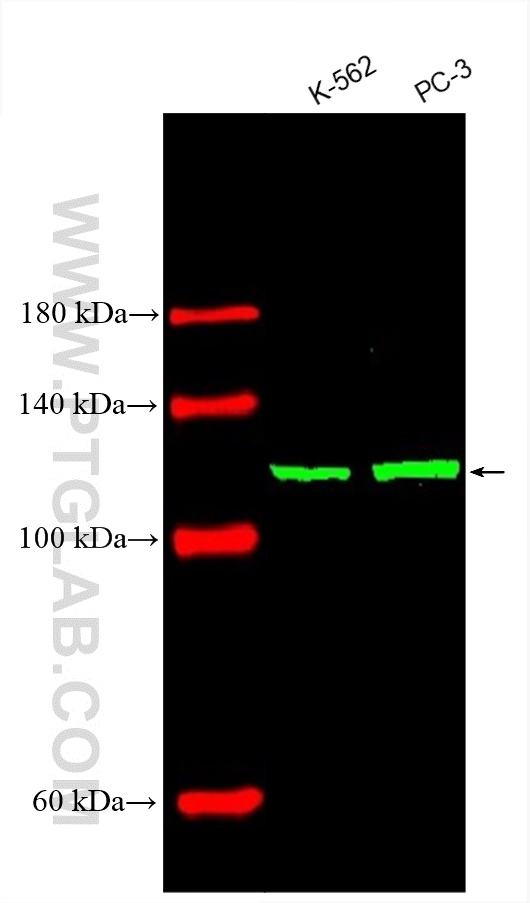验证数据展示
经过测试的应用
| Positive WB detected in | K-562 cells, PC-3 cells |
推荐稀释比
| 应用 | 推荐稀释比 |
|---|---|
| Western Blot (WB) | WB : 1:500-1:2000 |
| It is recommended that this reagent should be titrated in each testing system to obtain optimal results. | |
| Sample-dependent, Check data in validation data gallery. | |
产品信息
CL750-66305 targets Vinculin in WB applications and shows reactivity with human, mouse, rat, pig samples.
| 经测试应用 | WB Application Description |
| 经测试反应性 | human, mouse, rat, pig |
| 免疫原 | Vinculin fusion protein Ag24946 种属同源性预测 |
| 宿主/亚型 | Mouse / IgG1 |
| 抗体类别 | Monoclonal |
| 产品类型 | Antibody |
| 全称 | vinculin |
| 别名 | VCL, MVCL, MV, Metavinculin, CMD1W |
| 计算分子量 | 1133 aa, 124 kDa |
| 观测分子量 | 117 kDa |
| GenBank蛋白编号 | BC039174 |
| 基因名称 | Vinculin |
| Gene ID (NCBI) | 7414 |
| RRID | AB_3084892 |
| 偶联类型 | CoraLite® Plus 750 Fluorescent Dye |
| 最大激发/发射波长 | 755 nm / 780 nm |
| 形式 | Liquid |
| 纯化方式 | Protein G purification |
| UNIPROT ID | P18206 |
| 储存缓冲液 | PBS with 50% glycerol, 0.05% Proclin300, 0.5% BSA, pH 7.3. |
| 储存条件 | Store at -20°C. Avoid exposure to light. Stable for one year after shipment. Aliquoting is unnecessary for -20oC storage. |
背景介绍
Vinculin belongs to the vinculin/alpha-catenin family. It is an actin filament (F-actin)-binding protein which involved in cell-matrix adhesion and cell-cell adhesion. Vinculin regulates cell-surface E-cadherin expression and potentiates mechanosensing by the E-cadherin complex. It may also play important roles in cell morphology and locomotion. Vinculin is a 117-kDa, 1,066-amino-acid protein which is ubiquitously expressed. Its splice variant, metavinculin (124 kDa), is muscle-specific.
实验方案
| Product Specific Protocols | |
|---|---|
| WB protocol for CL Plus 750 Vinculin antibody CL750-66305 | Download protocol |
| Standard Protocols | |
|---|---|
| Click here to view our Standard Protocols |
